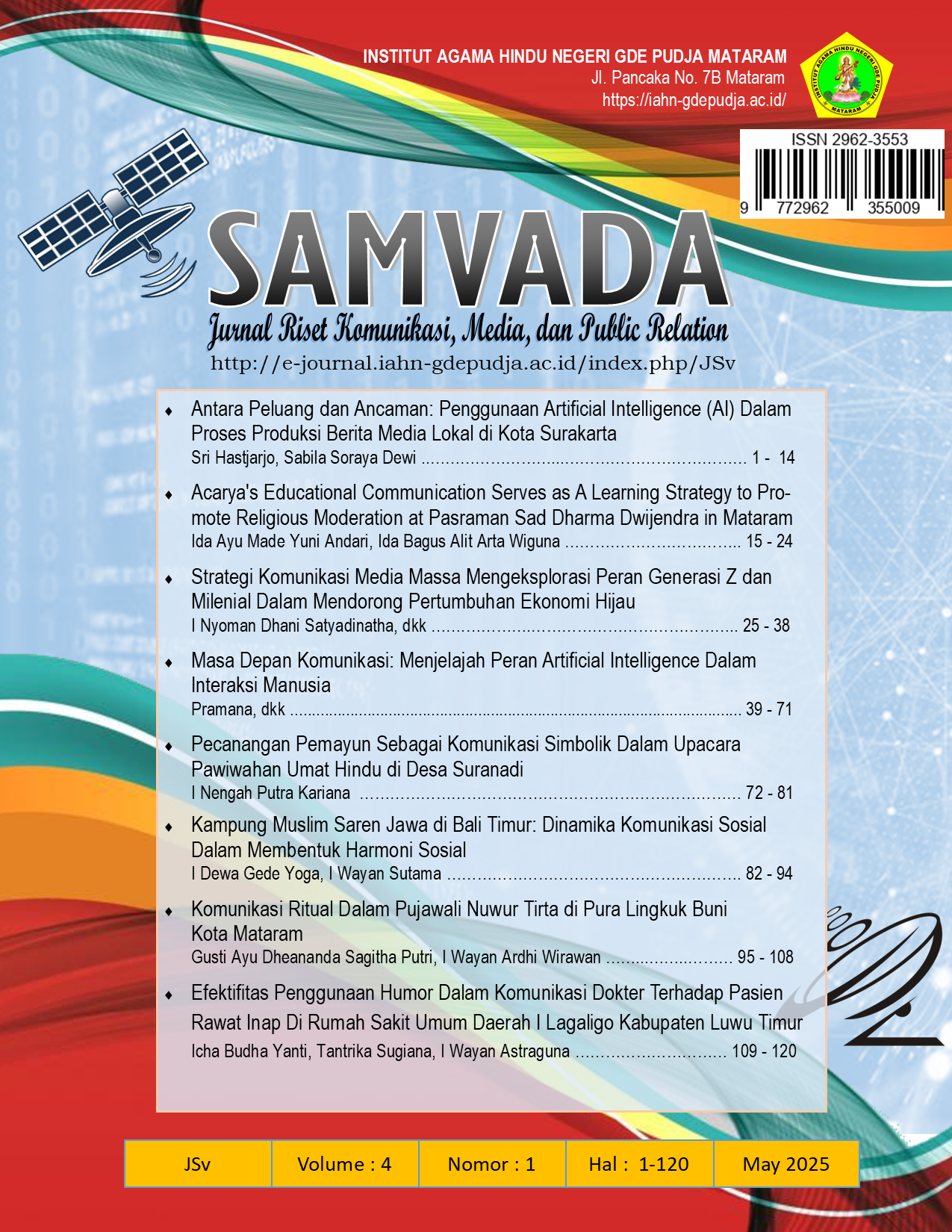PECANANGAN PEMAYUN SEBAGAI KOMUNIKASI SIMBOLIK DALAM UPACARA PAWIWAHAN UMAT HINDU DI DESA SURANADI
Abstract
The Hindu wedding ceremony or pawiwahan is inseparable from the role of the spokesperson, known as pemayun and pecanangan. This research aims to explain the communication process and the symbolic meaning of the pemayun tools in the pawiwahan ritual. The research was conducted in Suranadi village, with the subject of the study being the pemayun figures, and the object of the study being the pecangan or canang bebaos, which function as a symbol of communication between the groom's and bride's parties. The research method is a qualitative descriptive method, where the research findings will be narrated in words. The research results show that the communication process is carried out through face-to-face interpersonal communication, involving both primary and secondary communication processes, with the use of symbols of pecanangan pemayun in the wedding ceremony as a medium of communication. The symbols and meanings of the tools used are as follows: betel leaves or base symbolize friendship, areca nuts reflect harmony in married life, lime symbolizes "transition" to a new stage in life, gambir signifies the union of two individuals into one in marriage, and tobacco represents friendship and harmony between the extended families of both brides and grooms. These five symbols are communication symbols used by the payun in the Hindu wedding ceremony.
References
Hanani, S. (2017). Komunikasi Antarpribadi: Teori dan Praktik. In Yogyakarta: Ar-Ruuz Media (pp. 5–216).
Hanun, A. N. (2013). Komunikasi Antarpribadi Tunagrahita. In Jurnal Penelitian Komunikasi (Vol. 16, Issue 2). https://doi.org/10.20422/jpk.v16i2.36
Hardani, Helmina Andriani, Jumari Ustiawaty, Evi Fatmi Utami, Ria Rahmatul Istiqomah, Roushandy Asri Fardani, Dhika Juliana Sukmana, N. H. A. (2020). Buku Metode Penelitian Kualitatif. In Revista Brasileira de Linguística Aplicada (Vol. 5, Issue 1).
Karisma, K., Listiawati, N. P., Rasmini, N. W., & Suarjaya, I. N. A. (2023). Komunikasi Simbolik Dalam Tradisi Megibung di Kota Mataram. Samvada : Jurnal Riset Komunikasi, Media, Dan Public Relation, 2(2), 164–180. https://doi.org/10.53977/jsv.v2i2.1314
Ningsih, L. S., & Suwendra, I. W. (2020). Upacara Pawiwahan Dalam Agama Hindu. Jurnal Widya Sastra Pendidikan Agama Hindu, 3(2), 40–49. https://doi.org/10.36663/wspah.v3i2.74
Suarjaya, I. N. A., & Sutama, I. W. (2024). Penerapan Model Sadharanikaran Dalam Retorika Politik Modern Di Era Globalisasi. Samvada : Jurnal Riset Komunikasi, Media, Dan Public Relation, 3(1), 1–14. https://doi.org/10.53977/jsv.v3i1.1714
Wanesari, S. K., Prayitno, J., & Widaswara, R. Y. (2023). Komunikasi Sosial Dalam Menjaga Kerukunan Umat Beragama di Kelurahan Cakranegara Selatan Baru. Samvada : Jurnal Riset Komunikasi, Media, Dan Public Relation, 2(2), 181–193. https://doi.org/10.53977/jsv.v2i2.1315
Widaswara, R. Y. (2024). Pemberitaan Moderasi Beragama Di Desa Wisata Lombok Barat Dalam Media Online. Media Bina Ilmiah, 15(1), 37–48.
Widaswara, R. Y., & Jelantik, S. K. (2022). Branding Desa Wisata Toleransi Buwun Sejati Melalui Berita Online Mandalika Post. Widya Sandhi Jurnal Kajian Agama Sosial Dan Budaya, 13(2), 75–84. https://doi.org/10.53977/ws.v13i2.790



1.png)







